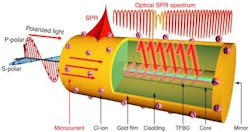Fiber-optic sensor monitors charge state of batteries and supercapacitors
A fiber-optic sensing system developed by researchers from Jinan University (Guangzhou, China) and the National Research Council of Canada and Carleton University (both in Ottawa, Ontario, Canada) can sense inside supercapacitors and batteries to observe their state of charge. Renewable energy sources are naturally inconsistent, and so require new energy storage technologies.1 Supercapacitors offer rapid charging and long-term storage, but it is important to be able to monitor their working state.
To tackle this issue, the team adapted an approach based on an optical fiber-based plasmonic sensor. The sensor is embedded inside the capacitor and is able to measure the state of charge of the electrodes and electrolytes in real time while it operates, and over its lifetime. The sensor demonstrated a clear and repeatable high correlation between measurements of the optical transmission of the fiber device and the supercapacitor's state of charge, offering a unique, low-cost method for real-time monitoring of energy storage devices in operation.
Present methods cannot measure real-time charge state information when the energy storage devices are in operation. They are required to take the supercapacitors off line (thus interrupting their function) and carrying out electrical measurements and, in some cases, opening up the supercapacitors to examine their components by electron microscopy.
The new plasmonic fiber-optics sensors are small enough to be inserted near the surface of the capacitor electrodes, and when based on telecommunication-grade fibers, can be left there and monitored remotely at any time and from any distance.
The new technology should have important implications for energy suppliers who rely on renewable energy sources from sun, wind, and hydroelectricity for at least part of their power-grid requirements. The main implication is that faulty or deteriorating capacitors can be identified before catastrophic failures can occur, and that no interruption of power systems will be required for testing them.
Source: https://www.eurekalert.org/pub_releases/2018-07/cioo-abo072918.php
REFERENCE:
1. Jiajie Lao et al., Light: Science & Applications (2018); https://doi.org/10.1038/s41377-018-0040-y

John Wallace | Senior Technical Editor (1998-2022)
John Wallace was with Laser Focus World for nearly 25 years, retiring in late June 2022. He obtained a bachelor's degree in mechanical engineering and physics at Rutgers University and a master's in optical engineering at the University of Rochester. Before becoming an editor, John worked as an engineer at RCA, Exxon, Eastman Kodak, and GCA Corporation.
